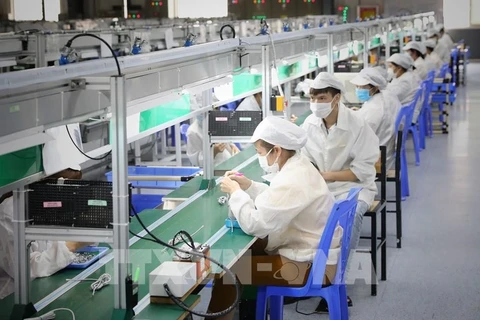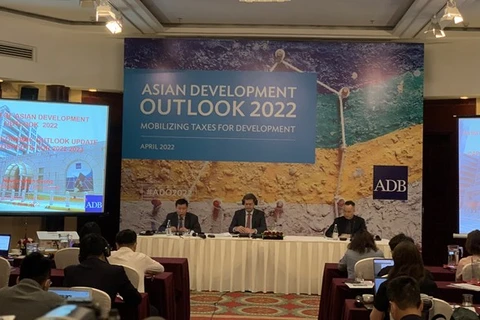Hanoi (VNA) – ADB experts have said growth is being pushed by the continuously broadening trade and the more-than-expected recovery of the production and manufacturing sector. This growth is also coupled with the increasing domestic travel and disbursement of the public investment, trending growth skyward.
In the publication Asian Development Outlook 2022 released by the Asian Development Bank (ADB) on July 21, the lender kept its growth forecast for Vietnam at 6.5% for 2022 and 6.7% for the next year, as it had announced in April.
ADB experts said growth is being pushed by continuously broadening trade and the more-than-expected recovery of the production and manufacturing sector. These gains are coupled with the increasing domestic travel and disbursement of the public investment.
They held that prices of commodities throughout the world, especially those of oil, will intensify the pressure of inflation. However, the abundant domestic supply of food will help ease the inflation in 2022. As a result, the forecast on inflation will be kept at 3.8% for this year and 4.0% for the next, as it was announced in April.
Recently, HSBC raised its growth forecast for Vietnam to 6.9% for this year instead of the previous 6.6% and, at the same time, lowered its growth forecast for the next year to 6.3% from the previous 6.7%.
HSBC experts held that after two quarters of reopening, the recovery of the Vietnamese economy remains a prominent example in the region. The GDP growth in the second half reached 7.7% over the same period last year, easily surpassing the expectations of the market (HSBC: 5.8%; think tanks: 5.9%). This is also the highest quarterly GDP growth Vietnam has ever recorded since 2011, thanks to the vigorous and extensive economic recovery in all the fields.
Thanks to the removal of the key restrictions on both domestic and international matters in mid-March, the fields related to tourism, especially those on travel and accommodation, have started to flourish. Meanwhile, the retail sale sector in the second quarter of this year skyrocketed by 17% over the same period last year, a sign showing that household consumption has started to recover.
The UOB of Singapore also raised its forecast of Vietnam’s GDP growth for this year to 7% from the previous level of 6.5%. This forecast goes along with the assumption that there will be no more disruptions caused by the COVID-19 pandemic and the GDP growth of the last half of this year will be about 7.6%-7.8%.
The UOB held that the strong recovery in Vietnam’s GDP growth in the second quarter of this year, prompted by production activities, has accelerated in the four consecutive quarters and the strong recovery of service activities have gradually regained the growth momentum since the last decrease in the third quarter of 2021.
In the first half of this year, Vietnam’s GDP grew by 6.4% over the same period last year, thanks to the 9.7% growth in production and the 6.6% growth in service activities.
Other monthly data also show that in general, economic activities are moving toward normal again, as restrictions relating to the COVID-19 pandemic have been loosened and borders reopened.
International bank forecasts on Vietnam’s economic growth for 2023 are positive also.
In its publication, the ADB also lowered its economic growth forecasts for the developing Asia and Pacific to 4.6% for this year. This is as a result of the slowing growth recorded by China, the further monetary tightening in developed countries, and the consequences of the war between Russia and Ukraina. This is slightly lower than its April forecast of 5.2%.
The bank also raised its warning against inflation in the region, as the prices of food and fuels are rising.
The publication also said the developing Asia and Pacific are continuing to recover after the COVID-19 pandemic, and many countries are loosening travel restrictions, facilitating economic activities. However, the growth in China – the biggest economy in the region – is slowing down as a result of the disruption caused by the new isolation orders triggered by the COVID-19 pandemic as well as the weakening demands all over the world.
ADB chief economist Albert Park said the economic impact of the pandemic has eased in most of Asia, but it is still far from the complete and sustainable recovery. Besides the stagnant growth of China, the consequences of the war in Ukraine has worsened the inflation pressure, forcing central banks in the world to raise the interest rates, thus holding back growth./.
In the publication Asian Development Outlook 2022 released by the Asian Development Bank (ADB) on July 21, the lender kept its growth forecast for Vietnam at 6.5% for 2022 and 6.7% for the next year, as it had announced in April.
ADB experts said growth is being pushed by continuously broadening trade and the more-than-expected recovery of the production and manufacturing sector. These gains are coupled with the increasing domestic travel and disbursement of the public investment.
They held that prices of commodities throughout the world, especially those of oil, will intensify the pressure of inflation. However, the abundant domestic supply of food will help ease the inflation in 2022. As a result, the forecast on inflation will be kept at 3.8% for this year and 4.0% for the next, as it was announced in April.
Recently, HSBC raised its growth forecast for Vietnam to 6.9% for this year instead of the previous 6.6% and, at the same time, lowered its growth forecast for the next year to 6.3% from the previous 6.7%.
HSBC experts held that after two quarters of reopening, the recovery of the Vietnamese economy remains a prominent example in the region. The GDP growth in the second half reached 7.7% over the same period last year, easily surpassing the expectations of the market (HSBC: 5.8%; think tanks: 5.9%). This is also the highest quarterly GDP growth Vietnam has ever recorded since 2011, thanks to the vigorous and extensive economic recovery in all the fields.
Thanks to the removal of the key restrictions on both domestic and international matters in mid-March, the fields related to tourism, especially those on travel and accommodation, have started to flourish. Meanwhile, the retail sale sector in the second quarter of this year skyrocketed by 17% over the same period last year, a sign showing that household consumption has started to recover.
The UOB of Singapore also raised its forecast of Vietnam’s GDP growth for this year to 7% from the previous level of 6.5%. This forecast goes along with the assumption that there will be no more disruptions caused by the COVID-19 pandemic and the GDP growth of the last half of this year will be about 7.6%-7.8%.
The UOB held that the strong recovery in Vietnam’s GDP growth in the second quarter of this year, prompted by production activities, has accelerated in the four consecutive quarters and the strong recovery of service activities have gradually regained the growth momentum since the last decrease in the third quarter of 2021.
In the first half of this year, Vietnam’s GDP grew by 6.4% over the same period last year, thanks to the 9.7% growth in production and the 6.6% growth in service activities.
Other monthly data also show that in general, economic activities are moving toward normal again, as restrictions relating to the COVID-19 pandemic have been loosened and borders reopened.
International bank forecasts on Vietnam’s economic growth for 2023 are positive also.
In its publication, the ADB also lowered its economic growth forecasts for the developing Asia and Pacific to 4.6% for this year. This is as a result of the slowing growth recorded by China, the further monetary tightening in developed countries, and the consequences of the war between Russia and Ukraina. This is slightly lower than its April forecast of 5.2%.
The bank also raised its warning against inflation in the region, as the prices of food and fuels are rising.
The publication also said the developing Asia and Pacific are continuing to recover after the COVID-19 pandemic, and many countries are loosening travel restrictions, facilitating economic activities. However, the growth in China – the biggest economy in the region – is slowing down as a result of the disruption caused by the new isolation orders triggered by the COVID-19 pandemic as well as the weakening demands all over the world.
ADB chief economist Albert Park said the economic impact of the pandemic has eased in most of Asia, but it is still far from the complete and sustainable recovery. Besides the stagnant growth of China, the consequences of the war in Ukraine has worsened the inflation pressure, forcing central banks in the world to raise the interest rates, thus holding back growth./.
VNA
























